There was more than one reason to remember the 5th of November this year. London optometrist Rod Whitereports from the last of this autumn's Replay conferences
Not only was it Bonfire Night, it was also the date of the fourth and final Replay Learning clinical conference of 2007. The venue, Charlton Athletic Football Club, was a somewhat unusual but entirely appropriate choice. Supporters of The Valley were still celebrating having beaten Manchester City the day before.

Anterior Eye
London optometrist Caroline Christie invited delegates into her imaginary consulting room to tell us some 'Tales from contact lens practice'.
Register now to continue reading
Thank you for visiting Optician Online. Register now to access up to 10 news and opinion articles a month.
Register
Already have an account? Sign in here
